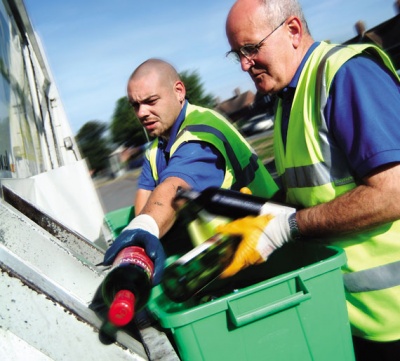EA reveals separate collections regulatory regime
The Environment Agency (EA) has today (22 December) revealed the ‘risk-based regime’ it will use to evaluate waste collectors’ compliance with the separate collection requirement of the Waste Regulations.

According to the regulations (which transpose the EU’s revised Waste Framework Directive (WFD) into law in England and Wales), by 1 January 2015, every waste collection authority must have in place separate collections for waste paper, metal, plastic and glass when they are necessary to ‘facilitate or improve recovery’ and are ‘technically, environmentally and economically practicable’ (TEEP). Collectors must be able to provide the EA with their necessity and TEEP tests when requested.
Although the UK government has not released details of what is considered TEEP and the Department for Environment, Food & Rural Affairs (Defra) has said it will not be publishing any guidance on the matter, the EA highlights that the Waste & Resources Action Programme's (WRAP) Waste Regulations Route Map, the Welsh Government’s statutory guidance, and the Resource Association's ReQIP tool on the recyclate quality requirements of 'some reprocessors' are ‘useful’ and good indicators of best practice.
The EA has previously highlighted that ‘it is not true that separate collection means that every household or business must have more bins [as] many areas have kerbside sort systems’.
But, in the EA’s updated briefing note on ‘Separate Collection of Recyclables’, sent out to local authorities and waste management companies today, it states that ‘collectors are expected to ensure in all cases that customers can avoid putting paper, plastic, metal or glass in the same collection container as their general waste. In addition, they are expected to collect paper, plastic, metal and glass separately from each other’.
Briefing note details
An EA spokesperson said: “The Environment Agency has written to remind waste collectors that they should collect recycled paper, glass, metals and plastic separately where this is technically, economically and environmentally practicable and necessary to produce high-quality recycling.
“These rules are being brought in as part of the Waste Regulations (2011) under the EU Waste Framework Directive. The aim is to help ensure that recycled materials are good enough to make new paper, glass, plastics and metal, so helping to reduce the amount of waste going to landfill, help the economy and improve the environment.”
The briefing note reads: ‘Every collector (Waste Collection Authority or establishment or undertaking collecting waste) must, when making arrangements for the collection of waste paper, metal, plastic or glass, ensure that those arrangements are by way of separate collection… Collectors who do not have separate collection arrangements should review their collection practices and consider carefully if and how they comply. They should rigorously apply the Necessity and TEEP tests.
‘Collectors who have concluded it not necessary or not TEEP to operate separate collection arrangements should keep, and be able to provide for inspection, an audit trail which will help the Environment Agency to understand the basis of their decision-making. Records should be such that, if necessary, they could demonstrate compliance with the regulations in a court of law. Collectors should consult their lawyers to ensure they are compliant with this legislation.’
Compliance level indicators
Notably, the document outlines that there are three levels of compliance: high, medium, and low. Those achieving high compliance with the Waste Regulations will receive a low level of intervention by the EA, while those achieving low compliance will receive high levels of EA intervention.
High
Waste collectors will be seen as achieving ‘high’ compliance if they:
- ‘provide on-site or doorstep separate collection, or kerbside sorting of each paper, glass, plastic and cans’ streams; and
- have ‘rigorously applied the Necessity and TEEP tests and arrangements are based on well-evidenced, documented and justified decision-making’.
Medium
Collectors will be deemed to be achieving medium levels of compliance (which could possibly fail the necessity or TEEP tests) if:
- a collector is ‘prescriptive’ about the type of collection/sorting service it is tendering for, unless it is clear it wants a multi-stream/separate collection;
- collectors send co-mingled collections to a materials recovery facility (MRF) that is producing ‘poor-quality recyclables’;
- collectors have moved from separate collections to co-mingled collections since 2012 (or have renewed co-mingling systems since 2012); and
- one or more of the four target materials are only collected through civic amenity or bring bank sites.
Low
Collectors will be classified in the lowest level of compliance if:
- collectors have taken no, or little, attempt to apply the regulations;
- they do not respond to requests for information from the EA;
- they deliberately send ‘good-quality recyclate’ for disposal, incineration, or remix them with other wastes; and
- they are known to be causing environmental harm or partaking in illegal activity such as mis-description or illegal export of waste.
Compliance will be assessed through ‘sources of information such as WasteDataFlow, the WRAP website, returns from Materials Facilities Regulations, eDoc and feedback from local people and [EA] Environment Officers’.
Where indicators suggest non-compliance, the EA will apply the following intervention measures, in ascending order, depending on the suspected level of compliance and the intent of the operator:
- Advisory phone call or letter seeking to explore and understand the collection activity, and whether improvements can or should be made;
- Meeting with operator/collector for discussion;
- Site inspection;
- Site audit;
- Enforcement notice;
- Warning letter;
- Formal caution; and, lastly
- Prosecution
Enforcement action will be a ‘last resort’
The note concluded that the body’s aim is to ‘help collectors to achieve compliance, but to be robust with those who deliberately ignore their obligations’. The EA said it will ‘work with collectors to help them to comply’ and would only take enforcement action as a ‘last resort’ as it is ‘costly and time-consuming to both parties’. The EA noted, however, that collectors should seek their own legal advice to support decisions they make on collection methods.
It reads: ‘We recognise that collection contracts can run for many years, and that collection infra-structure [sic] can have a long lifespan. Both can be prohibitively expensive to replace. We will act reasonably in considering such matters. The collection industry has known for several years that this legislation is due in January 2015. Also, even without wholesale changes to contracts, improvement measures can be made. Collectors will be required to show that they are taking all reasonable measures to comply with the regulations from January 2015, or within a reasonable time-frame.’
The note also revealed that the EA will be requesting information from collectors on their collection methods between January and March 2015, and that the first reporting on the quality of recyclables from MRFs will be released in June 2015.
An overview of the requirements are also available on the gov.uk website.
Industry reaction
Speaking following the release of the note, Policy Advisor for the Environmental Services Association (ESA), Jakob Rindegren, said: “We are pleased to see that the Environment Agency has finally published its briefing note for the separate collection of recyclable material. This note should help to give some guidance to our members and local authorities, not least on the agency’s approach to enforcing the new requirements.
"ESA has worked closely with the agency on the development of the briefing note, which we feel provides a reasonable overview of the new obligations for local authorities. There is, however, little steer for producers of business waste. Our members will of course continue to work closely with their commercial customers to help them comply with the changing rules."
The Resource Association's Chief Executive Ray Georgeson said: “In terms of the references to ‘high quality recycling’, we are grateful to the Environment Agency for the reference to the ReQIP quality specifications work that was conducted in 2014 and remains up to date. However , we note that the briefing note now states that the information provided is on the ‘recyclate quality requirements of some reprocessors.” [emphasis added]. We find the use of this word odd, as the ReQIP pages of our website clearly state that the information provided came from 36 individuals companies and associations representing 12,917,800 tonnes of UK reprocessing capacity which is a significant and major element of UK reprocessing, not just some.
“We assert again that the ReQIP specifications information for this large group of UK reprocessors represents a clear determination of what constitutes ‘high quality recycling’, noting that the Agency rightly reference Article 11(1) of the Waste Framework Directive stating that collections should ‘meet the necessary quality standards for the relevant recycling sectors.’ If nearly 13 million tonnes of dry recyclable and organic reprocessing capacity doesn’t constitute the relevant recycling sectors, then it would be interesting to understand what does.”
Read the EA's ‘Separate Collection of Recyclables’ briefing note.










